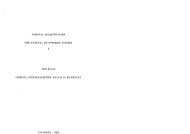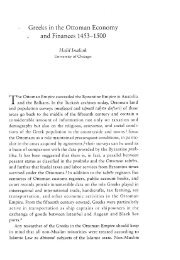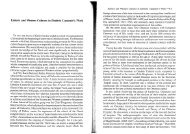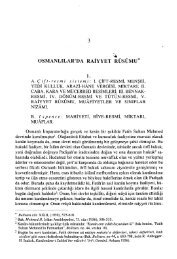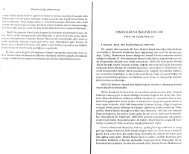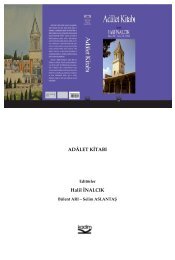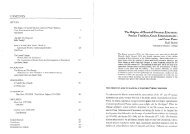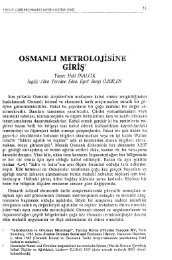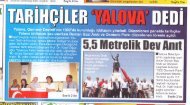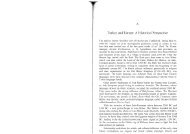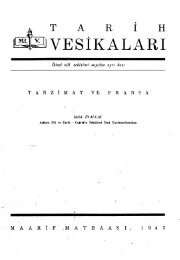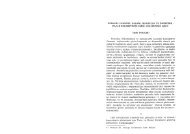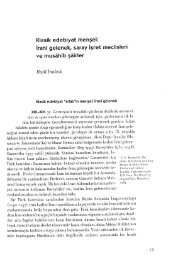Tbrsun B.g, Historian of Mehmed the Conqueror's Time
Tbrsun B.g, Historian of Mehmed the Conqueror's Time
Tbrsun B.g, Historian of Mehmed the Conqueror's Time
You also want an ePaper? Increase the reach of your titles
YUMPU automatically turns print PDFs into web optimized ePapers that Google loves.
426 = Halil Inalctk<br />
As for Tursun Beg's historiographical methodology and manner <strong>of</strong><br />
historical interpretation, he was firmly tied to <strong>the</strong> basic Islamic belief;<br />
that is to say, according to our author <strong>the</strong> course <strong>of</strong> history is<br />
predetermined by God's predestination. Thus, whatever project <strong>the</strong><br />
Sultan might undertake, its outcome was subject to this predestination,<br />
and success was granted to <strong>the</strong> Sultan in all his undertakings as<br />
a result <strong>of</strong> <strong>the</strong> backing and supporr. (te'ytd) <strong>of</strong> God (text pp. 15, 160,<br />
170, LgL, Lgg-90, 1gg).<br />
In <strong>the</strong> Ottoman state and <strong>the</strong> Islamic states which preceded it, <strong>the</strong>re<br />
had existed an <strong>of</strong>ficial or semi-<strong>of</strong>ficial school <strong>of</strong> historiography which<br />
was based on <strong>of</strong>ficial government documents, especially corespondence<br />
and memos to and frorn <strong>the</strong> Sultan (talkhl;at).3e Histories<br />
written by historians <strong>of</strong> this school are detailed and all-inclusive,<br />
usually giving precise and accurate information about <strong>the</strong> events<br />
described and <strong>the</strong>ir dates <strong>of</strong> occurrence. Ano<strong>the</strong>r category or school<br />
<strong>of</strong> historical writing, on <strong>the</strong> o<strong>the</strong>r hand, was exhibited in <strong>the</strong> personal<br />
histories based on <strong>the</strong> historian's own reminiscences or experiences<br />
ra<strong>the</strong>r than on <strong>of</strong>ficial documentation. Tursun Beg's history belongs<br />
in this second category. He states in his introduction (text p. 11) that<br />
he wrote his history using information about events which he had<br />
ei<strong>the</strong>r witnessed himself or information that was currently accepted as<br />
common public knowled ge ( "Beyn al-nas tevatur ile Eabit" ). For this<br />
reason, a great many mistakes are present both in <strong>the</strong> chronology and<br />
in <strong>the</strong> protagonists <strong>of</strong> events which he describes. There are many<br />
important events which we e not personally witnessed by <strong>the</strong> author<br />
and are <strong>the</strong>refore left uncovered in his work. It is for certain that his<br />
work is far from being a complete or comprehensive history <strong>of</strong> <strong>the</strong><br />
reign <strong>of</strong> <strong>Mehmed</strong> II. The importance <strong>of</strong> this history derives not from<br />
its completeness, but ra<strong>the</strong>r from <strong>the</strong> fact that it is based on <strong>the</strong><br />
personal reminiscences <strong>of</strong> a man, Tursun B"g, who served for forty<br />
years in <strong>the</strong> highest government circles, andwho was in close contact<br />
with <strong>the</strong> influential men and decision makers <strong>of</strong> his time. TheTarlkhi<br />
Abu'l-Fath thus constitutes a first hand source for <strong>the</strong> study <strong>of</strong> <strong>the</strong><br />
attitudes <strong>of</strong> <strong>the</strong> Ottoman ruling class, <strong>the</strong>ir inner power struggles, <strong>the</strong><br />
character and contents <strong>of</strong> <strong>the</strong>ir war councils, aspects <strong>of</strong> Ottoman<br />
society and culture whose private nature makes <strong>the</strong>m little susceptible<br />
to study through <strong>the</strong> <strong>of</strong>ficial and semi-<strong>of</strong>ficial histories. Tursun's<br />
work is also one <strong>of</strong> <strong>the</strong> most reliable sources for <strong>the</strong> personalities <strong>of</strong><br />
<strong>Mehmed</strong> II and Mabmld Pasha, as well as for an understanding <strong>of</strong> <strong>the</strong><br />
most important internal and external issues and problems <strong>of</strong> <strong>the</strong> day<br />
Tlrsun B.g, <strong>Historian</strong> <strong>of</strong> <strong>Mehmed</strong> <strong>the</strong> <strong>Conqueror's</strong> <strong>Time</strong> : 427<br />
as seen by an inside observer.The central importance <strong>of</strong> artillery for<br />
<strong>the</strong> Conqueror in his founding <strong>of</strong> <strong>the</strong> empire is thus one issue which<br />
is concretely confirmed by Tursun Beg's history. There can be no<br />
doubt whatsoever that it is <strong>the</strong> most important Ottoman source for <strong>the</strong><br />
period <strong>of</strong> <strong>Mehmed</strong> fl's reign.<br />
Like most <strong>of</strong> <strong>the</strong> milnshts, Tursun Beg was also apoet. The couplets<br />
and verses sprinkled throughouthis history give ample evidence <strong>of</strong> his<br />
quite considerable skill in <strong>the</strong> poetic arts. He was given a present <strong>of</strong><br />
a sable fur, a robe <strong>of</strong> honor, and 2,000 akgain cash for <strong>the</strong> poem which<br />
he presented to <strong>Mehmed</strong> II on his return to Edirne after <strong>the</strong> winter<br />
campaign <strong>of</strong> L47 6 (text pp. 165-66). He also celebrated <strong>the</strong> occasion<br />
<strong>of</strong> Bayezid II's first campaign and <strong>the</strong> conquest <strong>of</strong> Ak-Kerman and<br />
Kilia in 1484 by greeting <strong>the</strong> returning Sultan with a verse (text pp.<br />
189-90).<br />
Tursun Beg's history was written in <strong>the</strong> <strong>of</strong>ficial literary prose style<br />
which was in <strong>the</strong> process <strong>of</strong> development in Ottoman government<br />
circles at that time,ao and can thus be regarded as one <strong>of</strong> <strong>the</strong> first and<br />
most important examples <strong>of</strong> <strong>the</strong> fifteenth century Ottoman historical<br />
writing. This high-flown literary insha' language seems to have<br />
developed in <strong>the</strong> time <strong>of</strong> Murad II on <strong>the</strong> basis <strong>of</strong> imitation <strong>of</strong> Persian<br />
models,al and thus contains many anomalies which were not well<br />
incoqporated into <strong>the</strong> structure <strong>of</strong> <strong>the</strong> Turkish language nor firmly<br />
established in <strong>the</strong>ir usage. It is perhaps for this reason that <strong>the</strong> Tarthi<br />
Abu' I Fath was somewhat lacking in popularity among later generations<br />
<strong>of</strong> Ottoman historians.<br />
This work was, however, one <strong>of</strong> <strong>the</strong> principal sources upon which<br />
Kemll Pasha-zade relied when he composed <strong>the</strong> section <strong>of</strong> his history<br />
dealing with <strong>the</strong> reign <strong>of</strong> <strong>Mehmed</strong> II. Idris Bidlisi and Sa"d al-Din<br />
apparently remained unaware <strong>of</strong> <strong>the</strong> existence <strong>of</strong> Tursun's work.<br />
NOTES<br />
1. Our historian says (M. Arif, ed.ition, p. 8, see note 2 below) his<br />
name is originally Tur-SIna, a Qur'anic name distorted into Tursun<br />
meaning in Turkish, "let him survive." Tursun, a popular name<br />
extensively used in <strong>the</strong> period was evidently not liked by our author.<br />
Besides, apoet, flayati (Sehi, Tedhkire, Istanbul L325 H. p. 70) made<br />
fun <strong>of</strong> him by referring to <strong>the</strong> original meaning <strong>of</strong> Tursun, which our<br />
author resented.



